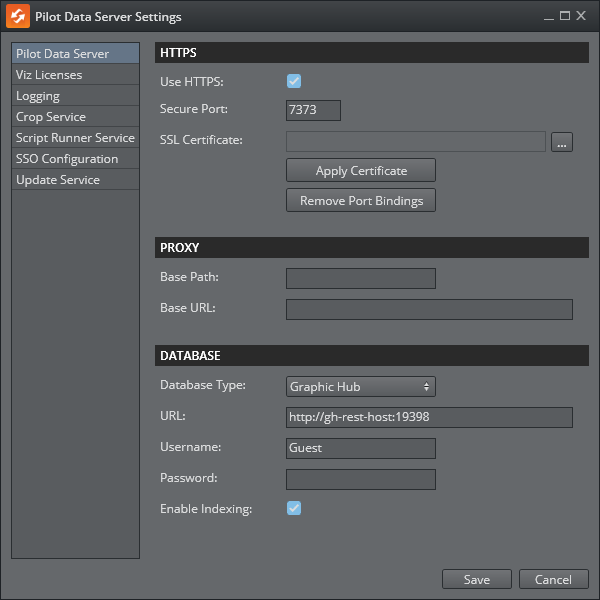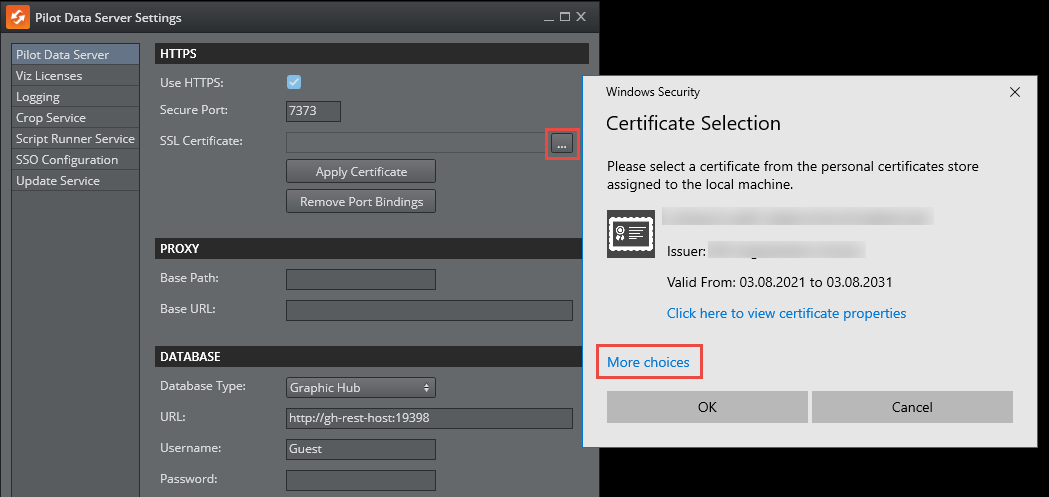The Settings File
Most of the Pilot Data Server settings are stored in a single file: %ProgramData%\Vizrt\Pilot Data Server\DataServerConfig.ini.
This file backs most of the settings in the Launcher Settings. This file can be manipulated without the Launcher running, but the Pilot Data Server service needs to restart if the settings are changed in the file. This file can also be copied to a target machine to pre-configure Pilot Data Server without entering the UI.
The Settings UI
HTTPS
Pilot Data Server can be configured to use the SSL transport layer when communicating. If HTTPS is configured, all endpoints of Pilot Data Server can be accessed using the HTTPS protocol.
Check Use HTTPS.
The default port suggested is 7373. This can be changed, but it is recommended to use this port.
Configuring SSL Certificates
To enable HTTPS for Pilot Data Server, you need to configure an SSL certificate, used by the server to secure communications. This involves selecting a certificate from the Windows Certificate Store, binding it to the configured port and application ID, and optionally removing existing port bindings if necessary.
Understanding SSL Certificates
An SSL certificate is a digital credential that enables a secure communication, by encrypting data transmitted between clients and the server. It verifies the server's identity to clients, ensuring trustworthiness. Certificates are stored in the Windows Certificate Store and can be accessed via specific logical stores and locations. Pilot Data Server uses the following:
Store Location
LocalMachine: This location stores certificates available to all applications and services on the machine.Certificates in this location typically require administrative privileges to access.
Store Name
My: Also known as the Personal store, it contains certificates intended for server-level use, such as those for HTTPS.
Configuring the Certificate for Pilot Data Server
To configure a certificate for Pilot Data Server, follow these steps:
Browse for a Certificate: Click the button next to the SSL Certificate text box to browse for a certificate.
Select a Certificate:
The Windows Certificate Store browser opens, defaulting to the
Mystore under theLocalMachinelocation.It may be necessary to click More choices in the dialog box to expand the list of certificates in the store.
Select a certificate that matches your server's domain or hostname. Ensure the certificate:
Is valid (not expired).
Contains the private key.
Is issued by a trusted Certificate Authority (CA), or is a custom certificate, such as a self-signed certificate, that you trust and intend to use.
Click OK to confirm your selection.
Apply the Certificate:
Once a certificate is selected, its “friendly name” appears in the text box. Hovering over the “friendly name” of the certificate shows more comprehensive info on the selected certificate.
Click the Apply Certificate button.
This action binds the certificate to the configured port and application ID using the
netshcommand.The command associates the certificate’s thumbprint with the application and ensures HTTPS is enabled.
Remove Existing Port Bindings (Optional):
If you need to remove existing certificate bindings for the configured port and application ID:
Click the Remove Port Bindings button.
This unregisters any current SSL certificate bindings associated with the application.
This operation only locates bindings done by the PDS launcher. Any manual bindings previously done are not detected. See note below.
Notes:
Search providers and Preview Server must also be in HTTPS environments in order for calls to them to work. To enable support for HTTPS requests for Preview Server, see the Preview Server Administrator Guide.
If necessary, to manually clear the HTTPS port configured using the Pilot Data Server Launcher (Pilot Data Server, Script Runner, Crop Server), clear from the sslcert and urlacl lists with the following commands:
netsh http delete sslcert ipport=0.0.0.0:7373
netsh http delete urlacl https://+:7373/
Proxy
Pilot Data Server can be installed along with a proxy/reverse-proxy server. See Proxy Support for more information.
Base Path: This setting modifies the internal URL only when no proxy server is configured. It appends a path segment to the internal URL, defining the endpoint where Pilot Data Server listens for requests. For example, if the internal Pilot Data Server URL is
http://mypds:8177, setting "pds" as the Base Path, changes the internal URL tohttp://mypds:8177/pds.Base URL: This setting rewrites the internal URL to an external-facing URL in every response, making it accessible through the proxy. This ensures that clients interact with a consistent URL that matches the proxy's external address. The Base URL must be provided as an absolute URL string. For example, setting the Base URL to
https://example.com/pdscauses the server to rewrite response URLs to match this external address.
Note: These two settings cannot be combined. Base URL takes precedence over Base Path.
Database Connection
Pilot Data Server can connect to either an Oracle or a Graphic Hub database. Select your preferred choice in the dropdown.
Graphic Hub
URL: Full URL to the Graphic Hub REST service.
Username: Username when Pilot Data Server connects to Graphic Hub.
Password: Password when Pilot Data Server connects to Graphic Hub.
Oracle
Data Source: A connection string with format hostname/servicename (SID ) to the Oracle database, for example localhost/vizrtdb.
Username: Username when Pilot Data Server connects to the Oracle Database.
Password: Password when Pilot Data Server connects to Oracle Database.
Configuring the Pilot Data Server HTTP Port
The default Pilot Data Server port is 8177. To change the port:
On the Pilot Data Server machine, open the ini file in a text editor: %ProgramData\Pilot Data Server\DataServerConfig.ini.
Replace the following setting: Port = 8177.
Configuring the STOMP Address
The default STOMP (Change Notifications API) port is 9876. This is used to form an URL to the STOMP server, sending change notifications to Media Sequencer. This URL is served out as a link in the /changelog end point of Pilot Data Server. Note that this URL cannot be put behind a proxy. The host name of the STOMP server must be accessible from the Media Sequencer host.
On the Pilot Data Server machine, open the ini file in a text editor: %ProgramData\Pilot Data Server\DataServerConfig.ini.
The STOMP address is built from two parts: The base URL and the port.
Changing the STOMP Address
The STOMP base URL is by default the same as the Pilot Data Server host address. It can be overridden by setting ChangeServerReportAddress in the ini file. The default port is 9876. Change this by setting ChangeServerPort in the ini file:
ChangeServerReportAddress = https://hostname.domain.comChangeServerPort = 9988The resulting STOMP URL is stomp://hostname.domain.com:9988/.
The STOMP base URL is also implicitly changed by the Pilot Data Base BaseUrl setting. For instance:
BaseUrl = https://baseurl.domain.comChangeServerPort = 9988The resulting STOMP URL is stomp://basurl.domain.com:9988/.


